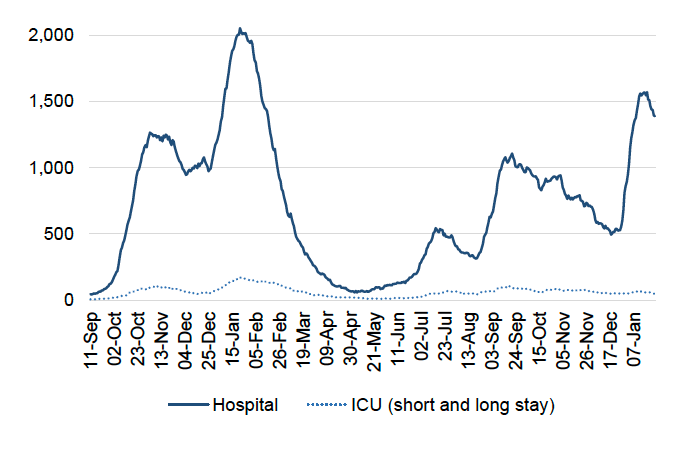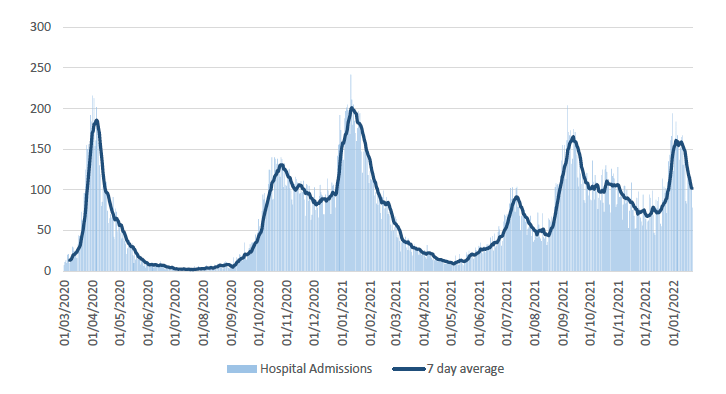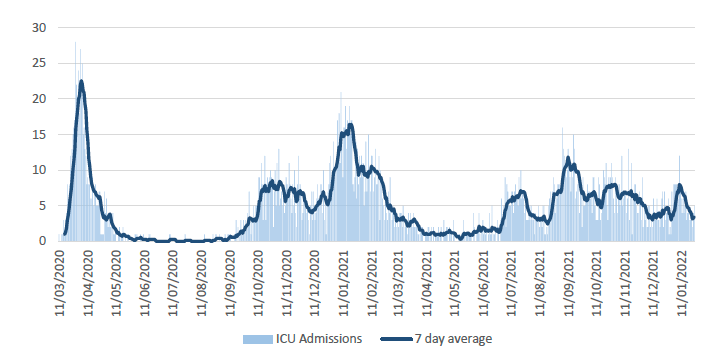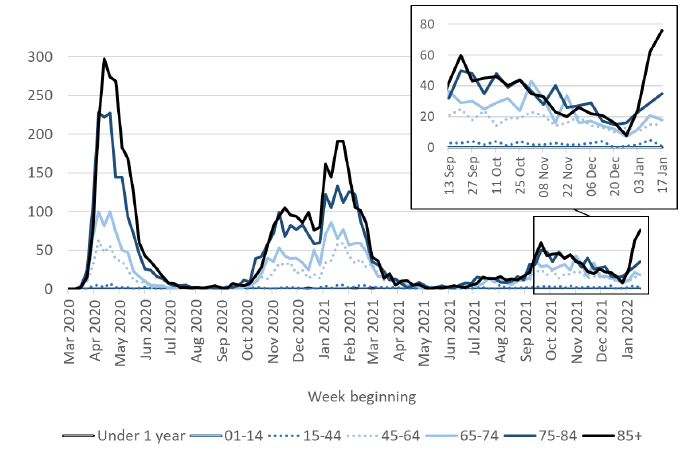Coronavirus (COVID-19): state of the epidemic - 28 January 2022
This report brings together the different sources of evidence and data about the Covid epidemic to summarise the current situation, why we are at that place, and what is likely to happen next.
This document is part of a collection
Severe Illness: Hospitalisation, ICU and Deaths
Hospital and ICU Occupancy and Admissions
In the week to and including 26 January 2022 Covid-19 hospital occupancy decreased. NHS boards reported 1,389 patients in hospital on 26 January with recently confirmed Covid-19, compared to 1,394 on 25 January and 1,571 a week previously (19 January 2022). This is a decrease of 182 patients, or 12%, from the previous week and compares with 2,053 patients in hospital at the peak in January 2021 (Figure 8).
ICU occupancy (including short and long stay) has decreased to 44 patients on 26 January 2022, a decrease of 16 patients or 27% since 19 January, and remains lower than the peak of 172 ICU patients recorded in January 2021 (Figure 8)[36]. There was a decrease in ICU patients in both short (28 days or less) and long (more than 28 days) stay ICU patients.

Admissions to hospital have decreased over the last week, with 711 admissions to hospital for people with confirmed Covid-19 in the week to 22 January 2022 compared to 983 in the week to 15 January (Figure 9)[38]. This is a 28% decrease.

Average hospital admissions (three-week rolling average) related to Covid-19 in children and young adults (aged under 22) have continued to increase overall in the week leading up to 19 January 2022 compared to the previous three-week period leading up to 12 January, and have surpassed the previous peak seen in September 2021. Hospital admissions related to Covid-19 in children are the highest since the start of the pandemic. The highest number (three-week rolling average) of hospital admissions in children and young adults was seen among those aged 0-1 in the three weeks leading up to 19 January. Age groups 2-4, 5-11 and 12-17 saw an increase in average hospital admissions in this time period, while those aged 0-1, 18-19 and 20-21 saw a slight decrease[40]. These figures refer both to young patients in hospital because of Covid-19 and with Covid-19.
The latest data from PHS shows 24 new Covid-19 patients admitted to ICU in the week to 25 January, compared to 33 in the week to 18 January (Figure 10)[41]. This is a 27% decrease. In the four weeks from 25 December 2021 to 21 January 2022, the rate of acute hospital admissions for individuals with a booster or third dose remains lower compared to unvaccinated people or those who have only received one or two doses of a Covid vaccine[42] [43].

A clinical audit from early and mid-January 2022 and further review of case notes shows that in NHS Greater Glasgow and Clyde, NHS Grampian, NHS Dumfries and Galloway and NHS Tayside[44], 64% of acute hospital admissions were 'because of' Covid-19 as opposed to coincidental 'with' Covid-19. This is slightly lower than the previously reported value of 68% from discharge summaries from NHS boards between March and August 2021, however these figures are not directly comparable.
Further analysis showed that 43% of all hospital admissions 'because of' Covid were in those aged over 65. Similar proportions of people in hospital 'because of' Covid-19 and 'with' Covid-19 were fully vaccinated. Data shows that 83% of hospital admissions with a known variant status in NHS Dumfries and Galloway and NHS Greater Glasgow and Clyde were infected with Omicron. This compares to just 36% in NHS Grampian. It is likely that the lower proportion of Omicron admissions in NHS Grampian reflects the different pace of variant transmission across Scotland. It should be noted that similar proportions of people with Omicron and Delta were admitted to hospital 'because of' their infections[45].
While it may be helpful to compare hospital occupancy between the UK nations, any comparisons must be made with caution. Definitions are not consistent across the nations and data are not reported daily by each nation. Additionally, data from Scotland, Wales and Northern Ireland is updated retrospectively if errors come to light. Data from England is not revised retrospectively, but instead is corrected in the following day's data update. For more information see UK Government website.
There were 16,594 confirmed Covid-19 patients in hospital in the UK on 25 January 2022, which is a 13% decrease from 19,052 on 18 January 2022[46]. How this is reported across the UK nations can be found in Table 1.
| Hospital occupancy on 25 January 2022 | Hospital occupancy on 18 January 2022 | Weekly % change in occupancy | |
|---|---|---|---|
| England | 14,088 | 16,218 | -13% |
| Scotland | 1,394 | 1,546 | -10% |
| Northern Ireland | 395 | 477 | -17% |
| Wales | 717 | 811 | -12% |
| UK | 16,594 | 19,052 | -13% |
Admissions to hospital have decreased by 15% across the UK over the last week, with 12,721 admissions to hospital for people with confirmed Covid-19 in the week to 22 January 2022 compared to 15,005 in the week to 15 January 2022. Hospital admissions across the UK nations can be found in Table 2.
| Admissions to hospital in the week to 22 January | Admissions to hospital in the week to 15 January | Weekly % change in admissions | |
|---|---|---|---|
| England | 11,576 | 13,449 | -14% |
| Scotland | 711 | 983 | -28% |
| Northern Ireland | 199 | 265 | -25% |
| Wales | 235 | 308 | -24% |
| UK | 12,721 | 15,005 | -15% |
Deaths
Covid-19 deaths most recently peaked in the week leading up to 26 September 2021, with 167 deaths registered in that week where Covid-19 was mentioned on the death certificate. After a period of decrease in Covid-19 death numbers throughout the last quarter of 2021, the three weeks leading up to 23 January 2022 have seen a sharp increase in the number of deaths where Covid-19 was mentioned on the death certificate, from 45 deaths in the week to 2 January 2022 to 145 deaths registered in the week to 23 January 2022. This is an increase of 222% in the three week period. However, numbers of Covid-19 deaths are still 78% lower than the peak in April 2020 (663 deaths)[49].
The recent increase in death numbers consists of fatalities among those aged 45 or above, as death numbers among younger age groups have remained at similar low levels throughout this period. While the age groups 45-64, 65-74 and 75-84 have all seen an increase in the number of deaths where Covid-19 was mentioned on the death certificate in three weeks to 23 January 2022, deaths involving Covid-19 increased the most among those aged over 85; this age groups saw an increase from 8 registered deaths in the week to 2 January to 76 deaths in the week to 23 January (Figure 11). National Records of Scotland publish a weekly detailed analysis on deaths involving Covid-19 in Scotland in their weekly report[50].

Excess deaths are the total number of deaths registered in a week minus the average number of deaths registered in the same week over the previous five years (excluding 2020). Measuring excess deaths allows us to track seasonal influenza, pandemics and other public health threats. Excess deaths include deaths caused by COVID-19 and those resulting from other causes.
In the week leading up to 23 January 2022, deaths were 5% below average levels for this time of year. This constitutes the third week in a row where deaths were below average[51].
While it may be helpful to compare deaths between the UK nations, any comparisons must be made with caution. Death definitions are not consistent across the nations. For more information see UK Government website.
There were 3 average daily deaths per one million population in the week leading up to 26 January 2022 in Scotland. In the same time period, average daily deaths for the other UK nations were as follows:
- England: 4 per one million
- Northern Ireland: 2 per one million
- Wales: 3 per one million[52].
Contact
There is a problem
Thanks for your feedback